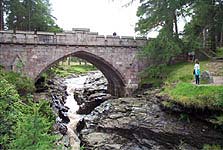The River Dee is considered the best Scottish example of a large, natural, highland river, its headwaters being among the highest of any river in the British Isles, up on the Braeriach plateau of the Cairngorms, at the Wells of Dee, 1,200 metres above sea-level.
Floods
Heavy rains and melting snows, can turn the river’s serene flow into a raging torrent. Major floods occurred in 1769, 1920 and the Cairngorm Flood of 1956. Most notable of all, though, was the Muckle Spate of August 1829.
Ferries
Historically there were a number of ferry points along the river, one of which was at the “Coble-heugh Inn”, where the Banchory Lodge Hotel now stands. James Humble, a ferryman in the early 19th century, related some wondrous tales of the strange beasts known as water kelpies that haunted the river. One of these creatures was said to have given warning prior to the death, by drowning, of one of the “floaters” who navigated the river.
Timber Transport
“Floaters” was the name given to those men who plied their hazardous trade by steering rafts of timber down the Dee from its upper reaches when the water was high. Their old river songs could be heard far and wide across the fields and through the trees. When the water was high, a floater could earn 21 shillings a raft for transporting timber down the Dee from the upper reaches down to Aberdeen.
The Silverbank Sawmill (Banchory) was opened in 1854 and timber would be delivered here and be loaded onto the newly arrived railway after treatment at the mill. As the railway progressed up the valley, it eventually replaced the need for river transportation of timber. The railway ceased with so many others in 1966 but the key stations in Aboyne and Ballater have survived and are now used as shops and cafés.
Royalty
Over a hundred years ago Queen Victoria chose Deeside as her holiday centre and successive generations of the Royal Family have followed her example. So too have generations of holiday makers, visiting the area renowned for the majestic scenery of mountain and river, and the many and varied associated sporting activities.





